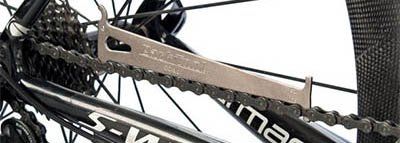Measuring chain wear
- by Trevor Moore
- •
- 21 Nov, 2018
- •

You want to replace your chain before it wears the rest of the drivetrain but how do you know when the chain is worn?
The simplest way is to use a Chain Wear Indicator / Checker tool. This has a 'heel' and a 'toe'. You place the heel between two rollers of the chain and then let the toe rest on the chain (see above image). If the toe doesn't fit between the rollers then the chain is fine. If the toe slots in between two rollers then the chain is worn and should be replaced (as in the image above).
Usually these tools are double sided.
One side is marked 0.75 or 0.075mm. If, when using this side, the toe goes in then the chain is worn to a degree where only the chain needs replacing.
The other side is marked 1.0 or 0.1 mm. If the toe on this side goes in then the chain is even more worn and the chain and gear cassette should be replaced as the very worn chain has worn the teeth on the sprockets of the cassette.
How many chains per cassette?
Usually you can use 2 to 3 chains on the one cassette if you replace then at the 0.75 stage. Obviously when the 3rd chain is showing 0.75 wear then the cassette should be replaced too so you will need to remember how many chains have been on that cassette!
So is it 2 or 3 chains per cassette? Good question! Its hard to say - there are so many factors involved in chain wear. Chain life is affected by riding style, gear choice (eg. cross chaining), the weather conditions ridden in, type of soil or surface you are riding on, type of lubricant used, lubrication techniques, and the chains quality.
If you have replaced the chain and you know the gear shift cables are running smoothly and the derailleur and shifters are all working well but you still have shifting issues then replacing the cassette as well will hopefully solve them.

I am sometimes asked whether its worth having your bike regularly serviced or to leave it until something goes wrong and get the problem fixed then.
There are number of problems with the latter course of action.
Firstly when something goes wrong and you're out on a ride it will inevitably happen in the middle of nowhere... in the rain.
You are either in for a long walk (possibly in cleats) or you had better hope your partner or best friend hears their phone and is able to drop everything to come out in their car to rescue you.
Secondly it can be dangerous.
A regular service can spot that your brake pads are completely worn away and have been eating through your wheel rim to the point that it might collapse on you.
Or that your brake pads aren't angled correctly and are wearing on the sidewall of your tyre - that friction heat will very quickly lead to a worn hole in the tyre and an exploding tube - not nice if its on the front tyre and you're going downhill.
Or the gunk on your rear derailleur has built up to the extent that the jockey wheels and chain could become jammed causing the rear derailleur to move up and over backwards into the rear wheel... broken derailleur, twisted chain, snapped spokes, snapped derailleur hanger are all possibilities then.
Also a service will check for chain wear leading to your chain being replaced before it snaps out on a ride!
Thirdly it's cheaper in the long run.
If you replace worn brake pads your wheel rim will last a lot longer. A wheel is an expensive item to replace , brake pads are not.
It doesn't cost that much to have your drive-train cleaned - a lot less then a new rear derailleur if its jams and flips over due to gunk.
Replace a worn chain at the right time and you can use 2 or 3 on a cassette. Let the chain overstretch and you will need to replace the chain and cassette.
So to sum up, regular maintenance :
1. saves you walking!
2. saves you getting injured!
3. saves you money!

